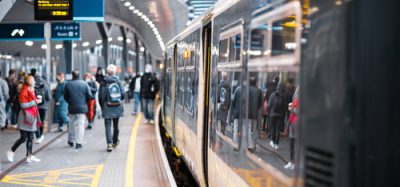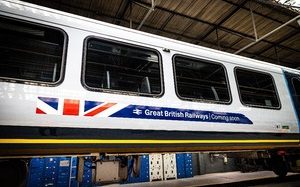SBB – service upgrades for tomorrow’s railway
Posted: 30 July 2007 | | No comments yet
Three years after the Rail 2000 project entered the operational phase, SBB now plans to introduce further service upgrades. In particular, the opening of the Lötschberg Base Tunnel in December 2007 will shorten journeys to Valais and Italy. The new timetable due to be introduced in December 2008 will see further improvements along the Gotthard route as well as in international services.
Three years after the Rail 2000 project entered the operational phase, SBB now plans to introduce further service upgrades. In particular, the opening of the Lötschberg Base Tunnel in December 2007 will shorten journeys to Valais and Italy. The new timetable due to be introduced in December 2008 will see further improvements along the Gotthard route as well as in international services.
Three years after the Rail 2000 project entered the operational phase, SBB now plans to introduce further service upgrades. In particular, the opening of the Lötschberg Base Tunnel in December 2007 will shorten journeys to Valais and Italy. The new timetable due to be introduced in December 2008 will see further improvements along the Gotthard route as well as in international services.
Since the major Rail 2000 timetable change in December 2004, SBB has seen both passenger numbers and passenger-kilometres rise. Passenger traffic volumes reached unprecedented levels in 2006 and this trend is set to continue. The upward trend was also clearly apparent in the first quarter of 2007. Compared to the same period last year, the total volume of passenger traffic rose by just under 6% to 73 million people. Passenger-km increased by just under 5% to 3.6 billion. This positive development could also be seen in terms of our regular customers. Sales volumes for the GA and Half-Fare travelcards have been rising since the start of the year (see chart). In order to capitalise on this very positive situation, SBB now needs to further upgrade its train services. The individual changes to be made to the 2008 and 2009 timetables are described below.
Domestic traffic 2008
From 9 December 2007 onwards, passengers will gain in terms of time, flexibility and comfort. Faster trains will be running on new routes with shorter travel times. The main changes to services arise from the opening of the Lötschberg Base Tunnel and the creation of new interchange stations at Interlaken Ost and Visp, which make the Bernese Oberland and Valais even more accessible. The changes can be broken down as follows:
The new interchange at Interlaken Ost will shorten journeys to the Jungfrau region by up to 19 minutes. Bern–Thun–Spiez–Visp–Brig or Basel–Visp or Zurich–Visp in 1 hour 59 minutes! Berne–Zermatt in 2 hours and 8 minutes! All of this will be made possible with the opening of the Lötschberg Base Tunnel on 9 December 2007. Trains will run at one-hour intervals between Romanshorn and Brig.
International traffic 2008
As of 10 June 2007, the French capital is now even closer to Switzerland. It takes only 3.5 hours to get to Paris-Est from Basel and 4.5 from Zurich. High-speed trains travel between Strasbourg and Paris at speeds of up to 320km/h. They arrive in the renovated Gare de l’Est station in Paris, from where passengers have only a short walk to the Gare du Nord, from where they can catch a Thalys service to Brussels or a Eurostar to London. Zurich will be linked to the French capital by super-modern TGV trains twice a day, and Basel four times a day. Starting from 9 December 2007, there will be three TGV trains leaving from Zurich and still four from Basel. The opening of the Lötschberg Base Tunnel will also shorten travel times on trains operating on the transalpine route between Switzerland and Italy. For the time being, four tilting trains will run daily on the Basel–Bern–Brig–Milan route. Travel times will be cut by approximately one hour compared to current services. Five trains a day will link Geneva Airport and Milan, one of which will continue to Venice.
Domestic traffic 2009
The 2009 timetable is the direct result of expansion along the Gotthard route. Here too passengers will gain in terms of time, flexibility and comfort. Faster tilting trains will run along the Arth-Goldau-Lugano route, shortening travel times by about 15 minutes. These tilting trains will also feature dining cars. With all IC trains running at 30-minute headways between the two business centres of Basel and Zurich, train services will be even better.
International traffic 2009
Here again, there will be train service upgrades between Switzerland and Paris. Starting from mid-2009, travel times will be brought down by an additional 30 minutes thanks to upgrading of the Haut-Bugey route. In addition, route upgrades between Frasne and Dijon should be completed by June 2009, which will shorten travel times by approximately 15 minutes on the Bern/Lausanne–Dijon–Paris routes. As of 2009, all Geneva–Milan services will be operated by ETR 610 tilting trains. This will shorten travel times by almost half an hour compared to conventional EuroCity (EC) trains.
Avoiding bottlenecks
The 2008 and 2009 timetable changes will considerably improve the competitiveness of the railways. At the same time, however, the new timetables will stretch available capacity on SBB’s network to the limit. Demand for track capacity for passenger and freight traffic will continue to rise in the future. This will require capital expenditures to expand the infrastructure. Expansion of the infrastructure was determined on the basis of analysis carried out during the ZEB Project (Future Development of the Railway Infrastructure). The planned expansion projects will bring benefits for the whole of Switzerland (see chart). A total of CHF 5.2 billion has been set aside for completion of the various projects. This funding will enable the following service enhancements to be made:
- Shorter travel times between Lausanne and Bern thanks to the use of tilting trains, with only one intermediate stop in Fribourg
- An additional train running between Lausanne and Bern for Palézieux and Romont
- An additional train running between Bern and Zurich
- Thirty-minute shorter travel times for long-distance trains on the Biel-Zurich route, with intermediate stops in Solothurn and Olten. One additional train per hour, stopping at new high-speed train stations along trunk routes
- IC trains running at half-hour headways on the Zurich–Winterthur–St. Gallen route, with no intermediate stops between Winterthur and St. Gallen. Additional trains for the Zurich–St. Gallen route, with intermediate stops in Wil, Flawil, Uzwil and Gossau
- Half-hour headways along the Biel–Neuchâtel–Yverdon–Lausanne/Geneva routes
- More trains running between Zurich and Lugano at peak times and days (holidays, etc.)
About the author
Paul Blumenthal has been Head of the SBB Passenger Traffic Division since 1993 and is also a member of the SBB Management Board. Overall, Mr. Blumenthal has been with SBB since 1981 when he joined as a graduate trainee.







